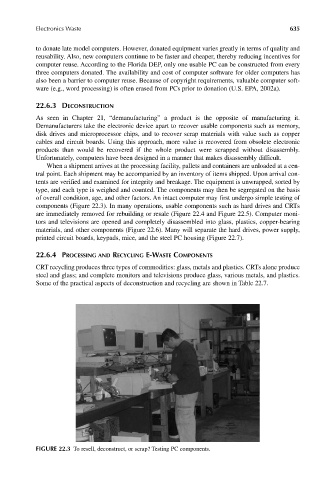Page 664 - Materials Chemistry, Second Edition
P. 664
CAT3525_C22.qxd 1/27/2005 1:00 PM Page 635
Electronics Waste 635
to donate late model computers. However, donated equipment varies greatly in terms of quality and
reusability. Also, new computers continue to be faster and cheaper, thereby reducing incentives for
computer reuse. According to the Florida DEP, only one usable PC can be constructed from every
three computers donated. The availability and cost of computer software for older computers has
also been a barrier to computer reuse. Because of copyright requirements, valuable computer soft-
ware (e.g., word processing) is often erased from PCs prior to donation (U.S. EPA, 2002a).
22.6.3 DECONSTRUCTION
As seen in Chapter 21, “demanufacturing” a product is the opposite of manufacturing it.
Demanufacturers take the electronic device apart to recover usable components such as memory,
disk drives and microprocessor chips, and to recover scrap materials with value such as copper
cables and circuit boards. Using this approach, more value is recovered from obsolete electronic
products than would be recovered if the whole product were scrapped without disassembly.
Unfortunately, computers have been designed in a manner that makes disassembly difficult.
When a shipment arrives at the processing facility, pallets and containers are unloaded at a cen-
tral point. Each shipment may be accompanied by an inventory of items shipped. Upon arrival con-
tents are verified and examined for integrity and breakage. The equipment is unwrapped, sorted by
type, and each type is weighed and counted. The components may then be segregated on the basis
of overall condition, age, and other factors. An intact computer may first undergo simple testing of
components (Figure 22.3). In many operations, usable components such as hard drives and CRTs
are immediately removed for rebuilding or resale (Figure 22.4 and Figure 22.5). Computer moni-
tors and televisions are opened and completely disassembled into glass, plastics, copper-bearing
materials, and other components (Figure 22.6). Many will separate the hard drives, power supply,
printed circuit boards, keypads, mice, and the steel PC housing (Figure 22.7).
22.6.4 PROCESSING AND RECYCLING E-WASTE COMPONENTS
CRT recycling produces three types of commodities: glass, metals and plastics. CRTs alone produce
steel and glass; and complete monitors and televisions produce glass, various metals, and plastics.
Some of the practical aspects of deconstruction and recycling are shown in Table 22.7.
FIGURE 22.3 To resell, deconstruct, or scrap? Testing PC components.

